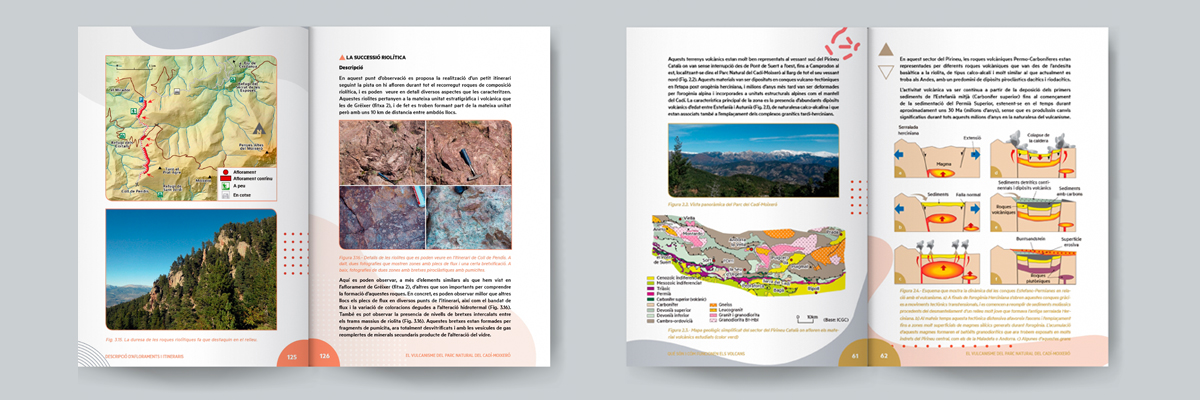The Cadi-Moixeró Natural Park has edited the new field guide entitled “El Vulcanisme al Parc Natural del Cadí-Moixeró“. Joan Martí, researcher at GEO3BCN-CSIc is one of the authors of the book, along with Llorenç Planagumà, geologist and environmental specialist, and Joan Casòliva, geologist and technician at the natural park.
This new field guide is aimed to improve and showcase the knowledge and the values of the Cadí-Moixeró Natural Park geological heritage, in particular, several volcanic outcrops of the area which are a reminder of past eruptions that occurred around 300 to 285 million years ago, between the Upper Carboniferous period to the Lower Permian period.
It was a global volcanic episode since it was one of the consequences of the tectonic process linked to the Hercynian Orogeny provoked by the Gondwana and Laurasia supercontinents collision. This collision was the origin of the Pangea supercontinent. The volcanic event spanned for about 30 million years, during which, according to Joan Martí, “a large perturbation in the Eart’s mantle occurred and large quantity of magma was generated both in the mantle and at the crust base”.

In the Catalan Pyrenees, and especially in the Cadi-Moixeró Natural Park, it is possible to find both the deposits of the eruptions occurring when the magma reached the surface, including lava and pyroclastic flows and also the plutonic bodies derived from the magmas that crystallized and cooled in the crust before reaching the surface. “It is a long period of magmatism that implies particular geodynamical conditions and that have implications to understand the Earth dynamics”, said Joan Martí. According to Joan Martí, the interest of the volcanic outcrops featured in the guide goes beyond touristic and scenic values. “Although the rocks of the outcrops are nearly 300 million years old, they are useful and interesting to understand the active volcanoes, since the outcrops show the roots of the ancient volcanoes, what we are not able to see in an active volcano. Therefore, it is a trip to the interior of the volcano”, said Martí.
According to the published researchs, the eruptions that occurred during the Permo-Carboniferous period were highly explosive and were triggered by magmas with a high gas content. Moreover, the deposits, where pyroclastic rocks are predominant, are related to caldera collapse events, one of the most destructive volcanic events. “The Cadí caldera, which occupied most of the park area, may have had a diameter of around 40kms”, said Martí.

The field guide is divided into 3 parts. The first part is a general introduction to the volcanoes and it is aimed to explain their nature, their formation processes, and their existence. The second part of the guide is focused on the vulcanism of the Cadí-Moixeró Natural Park. In this part, the authors feature and explain the origin of the 12 selected volcanic outcrops of the park. In the third part of the guide, several routes and itineraries are proposed to visit the selected outcrops.
The andesites of Coll de Vanses, the ignimbrites of the Cadí, the dacites of Prats d’Aguiló, or the riolithes from Grèixer are some of the outstanding outcrops featured in the guide, providing a panoramic view of the wide range of volcanic rocks and deposits linked to the Permo-Carboniferous volcanism.
“It is a guide made for hicking”, said Joan Martí. “The guide is intended to provide the readers the scientific knowledge in a proper way helping them to interpret what they are seeing. The guide can be also useful to make readers aware of the need to preserve the geological heritage, which is not renewable.”, concluded Martí.
More information
Martí, J., Planagumà, Ll., Casòliva, J. (2021) “El vulcanisme del Parc Natural del Cadí-Moixeró”. Parc Natural del Cadí-Moixeró. ISBN:978-84-18601-34-7
